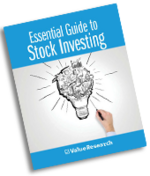
Value Research Stock Advisor has just released a new stock recommendation. You can click here to learn more about this premium service, and get immediate access to the live recommendations, plus new ones as soon as they are issued.
Buying an investment isn't the be all and end all of investing. Your timing as well as the manner in which you redeem your investments is an important part of the process. Disinvesting is in this sense the most crucial stage for your investments.
This may sound illogical, but it isn't, even if you are not the Government of India! Think about it. The goal of investing is to grow your money. However, this goal is accomplished only when you have taken your money out of your investments and placed it back in your bank account.
Of course, disinvesting the right way is less relevant when it comes to assured or all-but-assured savings like the PPF or fixed deposits. These investments will provide the expected return when they mature. Disinvesting is also not something that people who dabble in stocks and derivatives for short-term punting need to think about. However, having an exit strategy is crucial for those who are investing for the long term in equity-backed mutual funds in order to meet their financial goals.
There's a huge amount of money that now flows into equity mutual funds through SIPs every month. This is mainly a result of people investing their money for a specific life goal, which may be buying a house, financing an education, retirement or something else.
SIPs through equity funds offer far higher returns than fixed income options, enabling investors to meet these goals. Investing gradually means that investors are protected from most of the effects of equity volatility while they are investing. However, the value of the invested amount obviously goes up and down as the equity markets continue on their way. As is the way with equity, the underlying rate of return may be good, but it is hidden behind larger month-to-month and even yearly swings. It is entirely possible that just when the time comes for you to withdraw the money and use it for the purpose for which it was meant, its value is reduced by 10 or 20 per cent or even more.
So what should you do about this? How can you protect yourself from falling short of your goal? The answer is quite straightforward, but one that's rarely discussed by financial advisors. The way investors overcome volatility when investing (not just overcome, but turn it into an advantage) is by using SIPs. In much the same way, they must use SWPs or STPs (systematic transfer or withdrawal plans) while redeeming their money. The idea is very simple. About 12 to 18 months before you need to use a certain amount of money, start moving it to a stable debt fund category or to your bank account. Do it in equal monthly instalments. This doesn't take any great effort - all you need to do is to give the mutual fund a single instruction for the entire period and a fixed amount will either be redeemed or transferred to your bank account every month.
This effectively means that the exit value you get is an average across that entire period. That's the whole point of this exercise. In case the markets fall just before you actually have to use the money, you're still okay because a good part of the money has already been redeemed. At worst, the drop in value will affect a smaller part of the total funds withdrawn.
Of course, you must also be aware of the flip side of the coin. It is entirely possible (in fact, likelier) that this exercise will actually reduce your returns. If equity values rise during the period, then the average you will realise will actually be lower than the value at the end. What you do about it just depends on what you need the money for. If the need can be postponed for a year or two, then you can just wait. Otherwise, you should follow this safe exit plan.
A special case of this withdrawal problem is for retirees or anyone else who needs a regular income from investments. The basic principle remains the same - money should be moved to a less volatile investment a year or so before it is to be used.
When planning your investments, therefore, make sure you have not forgotten to create a plan to withdraw your money when the time comes. Do this systematically to avoid market downturns at inopportune moments, even if it means foregoing the best possible returns in the event of a market upswing. You have taken the trouble to invest systematically and grow your money. Don't let his effort and sacrifice be for nothing by failing to disinvest properly.



__w1000__h564__.jpg)





